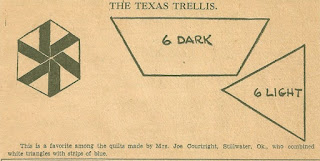Morris Hexathon 10: Thames Path by Becky Brown
I named this week's hexie Thames Path after the walking path along England's central river. (The English pronounce the river as Temz.)
William Morris had two homes named Kelmscott, both overlooking the Thames River. Kelmscott Manor was the family's summer home, located along the Upper Thames west of London.
Morris loved this part of the river, referring to it as the Baby Thames. He fished in it, he situated his furniture so he could have the best views and he fussed over any changes, writing letters (some more successful than others) to complain about alterations to the river's channel, modern roof materials on the boathouses or landscapers chopping wildflowers when cutting weeds.
The Thames River at Oxford
The Thames Path runs along the river 184 miles (294K). In 1880 the Morrises and friends made a week-long river journey on a house boat barge from the townhouse to the manor, a trip repeated the following summer.
"The barge has the greatest charm in my eyes. I always thought when I was a little girl in Oxford how much I should enjoy a voyage in one of those barges I used to see..."
Letter from Jane Burden Morris, August 29, 1879 (See Jan Marsh & Frank C. Sharp, The Collected Letters of Jane Morris, p 92.)

Google Earth Street View of Kelmscott House and the river
Kelmscott House in London also overlooks the river.
Morris named the town house after the ancient country manor.
Both houses now have public spaces with museums.
Kelmscott Manor:
Kelmscott House
The Thames Path
http://www.nationaltrail.co.uk/thames-path
Thames Path by Bettina Havig
The pattern is BlockBase #246, published several times in the early 20th century with names such as
- Hexagon
- Hexagon Beauty
- And Old Fashioned Wheel Quilt
- Spider Web
Pattern for an 8"
Hexagon
(4" sides)
To Print:
- Create a word file or a new empty JPG file that
is 8-1/2" x 11".
- Click on the image above.
- Right click on it and save it to your file.
- Print that file out 8-1/2" x 11". The
hexagon should measure 4" on the sides.
- Adjust the printed page size if necessary.
- Add seams when you cut the fabric.
Spider Web from Carrie Hall's collection.
Madame Hall didn't make this block (her center seams ALWAYS met perfectly)
but it's among her blocks at the Spencer Museum of Art at the University of Kansas.
The pattern seems to have been popular in red and white,
here ringing unpieced hexagon blocks.
All over...
Strips of pieced and plain hexagons
Same pattern, one an elegant quilt;
below a homely tied comforter, about 1900.
Varying the proportions gives different effects.
Above and below: two from about 1900-1915
An example from the 1950s set with white triangles
You've got two proportions this week
and two patterns from one geometry if you print
out both patterns.
Turn your triangles and it's BlockBase #245
Block 10 rotated by Ilyse Moore
Thames Path rotated by Becky Brown
BlockBase #245.
The proportion of triangle to quadrilateral can vary and give different effects. This pattern was first published in the Kansas City Star in July 1936, called Whirling Hexagon.
In 1943 they reprinted it as Texas Trellis.
Quilters Newsletter called it Whirling Triangles in 1975
Texas Trellis,
a long way from the Thames
Probably both made from Kansas City Star patterns.
This block has the homemade pattern pinned to it and the
name Whirling Hexagon written on the paper.
Again, if you don't want to do two blocks save the extra idea for a week when you think I have gone too far---too many pieces or too many curved seams. The time will come.
One More Inspiration
Rainbow Cube, Karen Combs






























Oh, I like both of these, thank you!
ReplyDeleteOrder my fabric, hope to have in I in this coming week. I order the program and got It in last week. Can't wait to have fun.
ReplyDeleteI love the Morris Hexagons! However, I am frustrated with my printer, which has been printing ghost images of everything ever since we downloaded Windows 10.
ReplyDelete